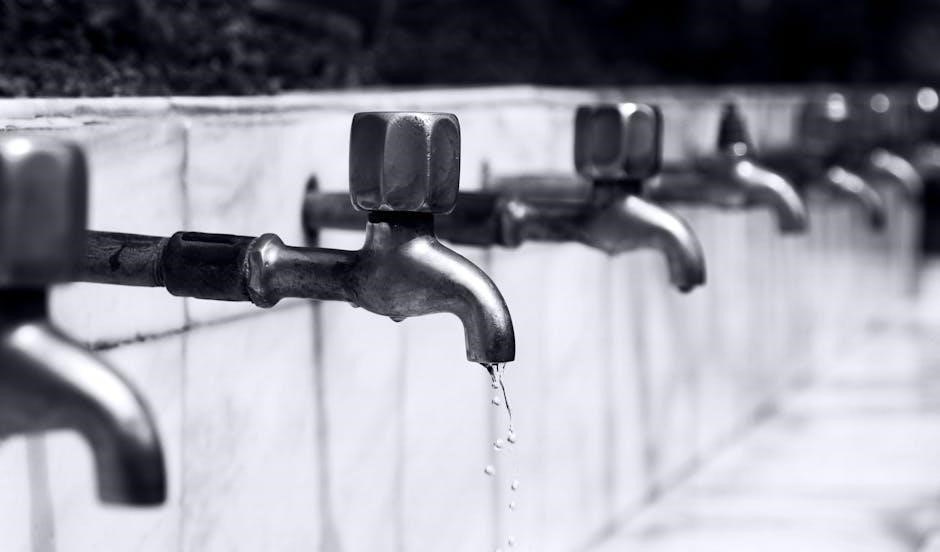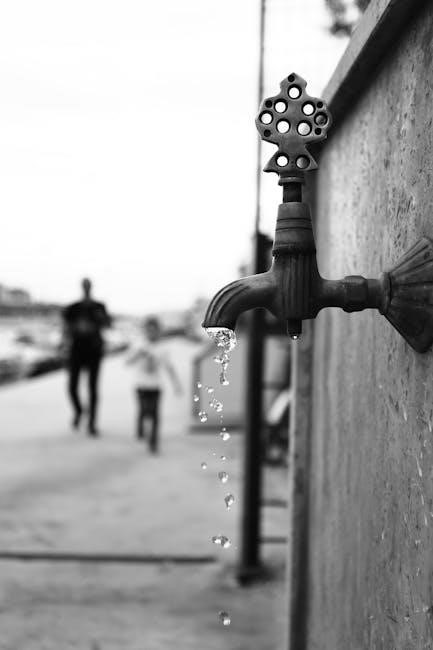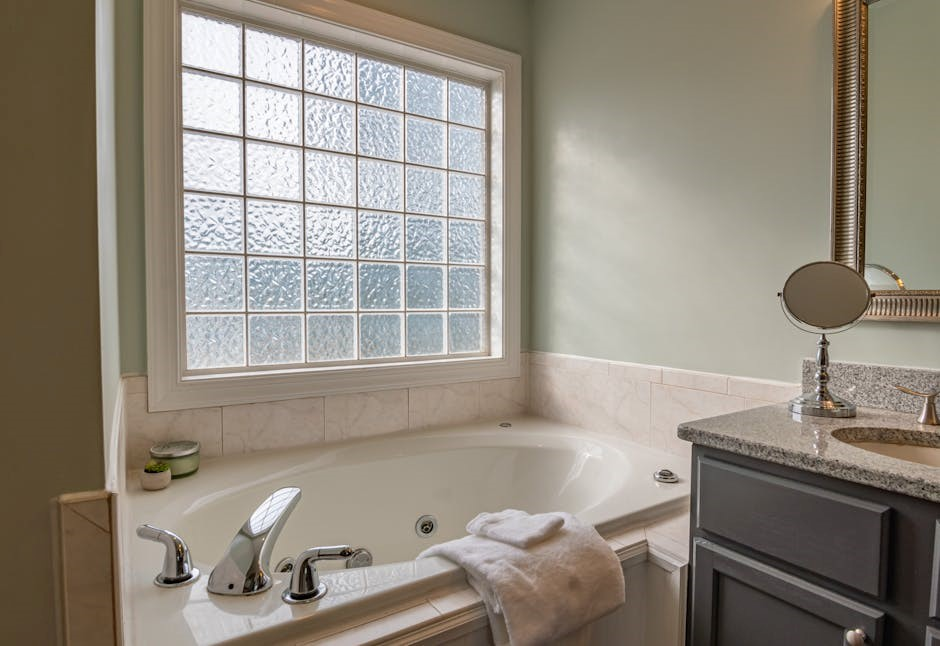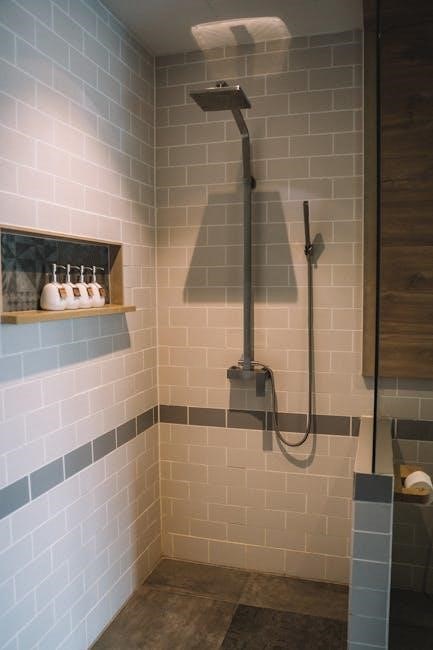Plumbing basics involve essential principles like providing potable water‚ installing fixtures‚ and designing drainage systems. Understanding these fundamentals ensures efficient water supply and waste management in residential and commercial spaces.
Essential Principles of Plumbing
Plumbing systems rely on core principles to ensure functionality and safety. These include providing potable water‚ installing adequate fixtures‚ and designing efficient drainage systems. A detailed list of 21 principles covers water supply‚ fixture design‚ drainage‚ and maintenance‚ ensuring proper system operation. Key aspects include water pressure management‚ venting‚ and trap requirements to prevent sewer gases. Proper sizing of pipes and fixtures is crucial for performance and efficiency. Understanding these principles helps in troubleshooting common issues like leaks or clogs. The ASPE Handbook offers authoritative guidance for designing and specifying plumbing systems. Additionally‚ water meters measure usage in cubic feet or gallons‚ with one cubic foot equaling 7.48 gallons. These principles form the foundation for maintaining hygiene and safety in both residential and commercial settings. Proper implementation ensures reliable water supply and waste removal‚ making plumbing a critical aspect of modern infrastructure.
Importance of Potable Water Supply
Potable water supply is a cornerstone of plumbing systems‚ ensuring access to safe and clean water for drinking‚ cooking‚ and hygiene. Its importance cannot be overstated‚ as it directly impacts public health and safety. Contaminated water can lead to severe health issues‚ making water quality a top priority. Plumbing systems are designed to deliver potable water reliably‚ preventing the spread of diseases. Adequate water pressure and flow rates are essential for proper fixture operation‚ ensuring effective cleaning and waste removal. Properly designed systems also protect against cross-connections‚ where contaminated water could mix with the potable supply. Regular maintenance and testing are crucial to uphold water quality standards. The ASPE Handbook provides detailed guidelines for ensuring safe and efficient water distribution. In summary‚ a reliable potable water supply is vital for maintaining hygiene‚ health‚ and overall quality of life in both residential and commercial environments.
Overview of Sanitary Drainage Systems
Sanitary drainage systems are essential for safely removing wastewater and sewage from buildings‚ protecting public health and preventing environmental contamination. These systems consist of underground pipes‚ traps‚ and vents that convey waste to treatment facilities or septic systems. Properly designed drainage systems ensure hygiene by preventing sewer gases and contaminants from entering living spaces. Traps‚ such as P-traps under sinks‚ create water seals to block gas entry‚ while vents maintain air pressure for smooth drainage flow. The design must adhere to local regulations and ensure proper slopes for gravity-fed systems. Failure in drainage systems can lead to health hazards and property damage. Regular maintenance‚ including inspections and clearing blockages‚ is crucial for functionality. Modern materials like PVC and ABS pipes offer durability and resistance to corrosion‚ enhancing system longevity. A well-designed sanitary drainage system is a critical component of modern plumbing infrastructure.
Key Components of Plumbing Systems
Plumbing systems consist of several key components that work together to deliver water‚ remove waste‚ and regulate flow. The primary elements include pipes‚ which transport water and waste; fittings‚ such as elbows and tees‚ that connect pipes; and valves‚ which control water flow. Water heaters‚ pumps‚ and pressure-regulating devices are also essential for ensuring consistent water supply and temperature. Additionally‚ fixtures like sinks‚ toilets‚ and showers serve as endpoints for water delivery and drainage. Traps and vents prevent sewer gases from entering buildings and maintain proper system pressure. Modern systems often incorporate materials like PEX‚ copper‚ and PVC for durability and corrosion resistance. Each component plays a critical role in maintaining functionality‚ safety‚ and hygiene in both residential and commercial settings. Proper installation and maintenance of these components are vital to prevent leaks‚ blockages‚ and system failures.

Plumbing Fixtures and Appliances
Plumbing fixtures like sinks and toilets‚ along with appliances such as water heaters‚ are crucial for water delivery and drainage. Proper installation ensures functionality and efficiency‚ enhancing user comfort and resource conservation.

Types of Plumbing Fixtures
Plumbing fixtures are essential components that deliver water and enable drainage in buildings. Common types include sinks‚ toilets‚ showers‚ bathtubs‚ and water heaters. Fixtures vary by purpose‚ design‚ and material‚ such as ceramic‚ metal‚ or plastic. Residential fixtures prioritize aesthetics and functionality‚ while commercial ones focus on durability and high usage. Faucets‚ urinals‚ and drinking fountains are also key fixtures. Proper selection and installation ensure water efficiency and long-term performance. Fixtures must comply with local plumbing codes and water conservation standards. Modern designs often incorporate low-flow technology to reduce water usage. Choosing the right fixture depends on the intended use‚ available space‚ and personal preferences. Regular maintenance is crucial to prevent leaks and ensure optimal operation. Understanding fixture types helps homeowners and professionals make informed decisions for new installations or renovations.
Installation and Maintenance Tips
Proper installation and maintenance are critical for ensuring the longevity and efficiency of plumbing systems. Always follow manufacturer guidelines for fixture installation to avoid leaks and damage. Use high-quality materials‚ such as PEX or copper pipes‚ and ensure connections are secure. Regularly inspect pipes for signs of wear‚ corrosion‚ or blockages. Drain water heaters annually to remove sediment and maintain performance. Fix leaks promptly to prevent water damage and mold growth. Use drain screens to catch debris and avoid clogs. Schedule professional inspections every few years to identify potential issues early. Maintain a plumbing toolkit with essentials like a pipe cutter‚ adjustable wrench‚ and plunger. Keep emergency shut-off valves accessible in case of emergencies. Proper maintenance not only saves money but also ensures a reliable water supply and drainage system. DIY enthusiasts should start with small tasks and seek professional help for complex jobs.
Choosing the Right Fixtures for Your Needs
Choosing the right plumbing fixtures involves considering factors such as water efficiency‚ durability‚ and aesthetic appeal. Start by assessing your lifestyle and usage patterns to determine the best fit for your home. For example‚ low-flow showerheads and dual-flush toilets are excellent for water conservation. Faucets with touchless or motion-sensing technology offer convenience and hygiene. When selecting fixtures‚ ensure they are compatible with your plumbing system’s water pressure and pipe size. Measure the space where the fixture will be installed to avoid sizing mismatches. Materials like stainless steel‚ brass‚ or ceramic are durable and resistant to corrosion. Consider energy-efficient and eco-friendly options‚ such as fixtures with the WaterSense certification. Additionally‚ think about maintenance needs and repair availability. Consulting with a professional can help you make informed decisions. Always check warranties and customer reviews to ensure you’re purchasing a reliable product. Proper selection enhances functionality and long-term satisfaction.
Common Issues with Plumbing Fixtures
Plumbing fixtures often encounter issues that require prompt attention to prevent further damage. Leaks are among the most common problems‚ often occurring in faucets‚ toilets‚ or pipes due to worn-out washers or gaskets. Clogged drains are another frequent issue‚ caused by debris buildup or improper waste disposal. Low water pressure can result from mineral accumulation‚ pipe blockages‚ or poor installation. Additionally‚ toilets may experience flushing issues‚ such as weak flushes or continuous running‚ often due to faulty flappers or fill valves. Showerheads and faucets can suffer from mineral buildup‚ reducing water flow. Improper installation of fixtures can lead to recurring problems‚ while outdated or low-quality fixtures may malfunction sooner. Regular maintenance‚ such as cleaning aerators and inspecting seals‚ can help prevent these issues. Addressing these problems early ensures efficient operation and extends the lifespan of plumbing fixtures;

Plumbing Tools and Materials

Plumbing requires essential tools like pipe cutters‚ wrenches‚ and drain snakes‚ along with materials such as PEX tubing‚ PVC pipes‚ and fittings to ensure efficient system installations and repairs.
Essential Tools for Plumbing Tasks
Plumbing tasks require a variety of essential tools to ensure efficiency and accuracy. Common tools include pipe wrenches‚ adjustable pliers‚ and tube cutters for cutting and shaping pipes. Drain snakes and augers are used to clear clogs in pipes and drains. A plunger is a must-have for resolving minor blockages in toilets and sinks. Basin wrenches are ideal for reaching and tightening fittings in confined spaces. Additionally‚ tools like Teflon tape and pipe benders are crucial for sealing threaded connections and shaping pipes without causing damage. For soldering and brazing‚ torches and heat-resistant flux are necessary. Properly maintaining these tools by cleaning and storing them in a dry place ensures longevity. Understanding how to use each tool correctly is vital for successful plumbing repairs and installations.

Materials Used in Plumbing Systems
Plumbing systems rely on a variety of materials to ensure durability and functionality. Copper piping is a traditional choice‚ known for its durability and resistance to corrosion. PEX tubing‚ a flexible and corrosion-resistant option‚ is increasingly popular for water supply lines due to its ease of installation. PVC pipes are commonly used for drain lines because they are lightweight‚ affordable‚ and resistant to chemicals. Galvanized steel pipes‚ though durable‚ can rust over time and are often used for water supply in older systems. Brass fittings are preferred for their strength and resistance to corrosion‚ making them ideal for high-pressure applications. CPVC‚ a chlorinated version of PVC‚ is suitable for both hot and cold water lines. The choice of material depends on factors like water pressure‚ temperature‚ and local building codes. Selecting the right materials ensures safety‚ efficiency‚ and longevity of the plumbing system.
Proper Use and Maintenance of Tools
Proper use and maintenance of plumbing tools are essential for ensuring safety‚ efficiency‚ and longevity. Always follow the manufacturer’s guidelines for tool usage to avoid damage or injury. Regularly clean and inspect tools for wear or damage‚ replacing any faulty components promptly. Store tools in a dry‚ organized space to prevent rust and loss. For example‚ pipe wrenches and pliers should be kept in a cool‚ dry area‚ while cutting tools like pipe cutters should be stored with protective covers. Sharpen cutting edges regularly to maintain effectiveness‚ and apply lubricants to moving parts to reduce friction. Organize tools in a toolbox or on a work belt to streamline workflows. Additionally‚ always use protective gear‚ such as gloves and safety glasses‚ when operating power tools. A well-maintained set of tools ensures smoother operations and reduces the risk of accidents. Regular maintenance also helps extend the lifespan of tools‚ saving costs over time.

Water Supply Systems

Water supply systems distribute water from sources to end-users‚ ensuring reliability and quality. They are vital for modern life‚ comprising essential infrastructure and advanced technology.
Municipal Water Supply vs. Well Water
Municipal water supply and well water are two primary sources of water for plumbing systems. Municipal water is treated and distributed by local governments‚ ensuring safety and quality through rigorous regulations. It is reliable and widely available‚ making it ideal for urban and suburban areas. Well water‚ on the other hand‚ is sourced directly from underground aquifers‚ offering independence from public systems. It is often less expensive in the long term but requires regular testing and maintenance to ensure quality. Well water is commonly used in rural areas where municipal services are unavailable. Both systems have their advantages‚ but municipal water is generally more consistent and regulated‚ while well water provides autonomy and potential cost savings. Understanding these differences is crucial for selecting the right water source for specific needs.
Water Meters and Usage Calculation
Water meters are essential devices used to measure water consumption in plumbing systems. They provide accurate data on water usage‚ helping homeowners and businesses monitor their consumption. There are two main types: mechanical meters‚ which measure flow through moving parts‚ and smart meters‚ which offer digital readings and remote monitoring. Understanding how to read a water meter is crucial for tracking usage and identifying potential leaks. To calculate water usage‚ measurements are taken over specific periods‚ such as daily or monthly. This data helps in assessing water efficiency and billing purposes. Regular monitoring can also detect anomalies‚ ensuring timely repairs. Accurate water usage calculation is vital for managing resources effectively and reducing waste. By leveraging meter data‚ individuals can make informed decisions to optimize water consumption and lower costs.
Water Treatment Basics
Water treatment is a critical process in plumbing systems‚ ensuring water is safe and suitable for consumption and use. The primary goal is to remove contaminants such as bacteria‚ viruses‚ and impurities. Treatment methods include coagulation‚ sedimentation‚ filtration‚ and disinfection. Coagulation involves adding chemicals to bind dirt and particles‚ forming larger clumps that settle out during sedimentation. Filtration removes remaining impurities by passing water through sand‚ gravel‚ or other media. Disinfection‚ often using chlorine or UV light‚ kills harmful microorganisms. Additional techniques like reverse osmosis and distillation provide higher levels of purification for specific needs. Regular maintenance of treatment systems is essential to ensure effectiveness and prevent contamination. Understanding these basics helps homeowners and plumbers implement appropriate water treatment solutions‚ ensuring a reliable and safe water supply.

Sanitary Drainage Systems
Sanitary drainage systems collect and dispose of wastewater and sewage‚ maintaining hygiene and preventing contamination. They rely on gravity and traps to function efficiently and prevent sewer gases from entering buildings.
Design Principles for Drainage Systems
Proper design of sanitary drainage systems ensures efficient wastewater disposal and prevents health hazards. Key principles include maintaining a consistent slope‚ typically 1/4 inch per foot‚ to allow gravity flow without clogging. Vent pipes are essential to equalize air pressure‚ preventing siphoning of traps. Traps in fixtures like sinks and toilets trap water‚ blocking sewer gases from entering buildings. Drainage lines must be sized correctly to handle anticipated flow rates‚ avoiding overloading. Materials like PVC and ABS are preferred for durability and resistance to corrosion. Proper connections to the main sewer or septic system are critical. Regular inspections and maintenance ensure system longevity. Adhering to local plumbing codes guarantees compliance with safety and performance standards. A well-designed drainage system minimizes backups‚ odors‚ and contamination risks‚ ensuring a safe and hygienic environment.
Traps and Vents in Plumbing
Traps and vents are critical components in plumbing systems‚ ensuring proper drainage and preventing sewer gases from entering buildings. Traps are curved pipes installed under fixtures like sinks and toilets‚ holding a small amount of water to create a seal. This prevents harmful gases and odors from rising into living spaces. Vents‚ on the other hand‚ are vertical pipes connected to the drainage system‚ extending through the roof. They allow air to enter the pipes‚ balancing pressure and preventing siphoning of water from traps. Proper venting ensures smooth drainage flow and prevents clogs. Traps and vents work together to maintain hygiene‚ safety‚ and system efficiency. Regular maintenance‚ such as checking for blockages‚ is essential to keep these components functioning effectively. Their correct installation and upkeep are vital for a reliable and odor-free plumbing system.
Connection to Sewer Systems
Connecting a building to a sewer system is a fundamental aspect of plumbing‚ ensuring the safe removal of wastewater and sewage. This connection involves linking the property’s drainage system to the municipal sewer or a private septic system. Proper installation is crucial to prevent issues like backups‚ overflows‚ and environmental contamination. Sewer lines are typically underground and must be sloped correctly to allow gravity to facilitate flow. Materials like PVC and ABS are commonly used for sewer pipes due to their durability and resistance to corrosion. Regular maintenance‚ such as clearing blockages caused by debris or tree roots‚ is essential to maintain functionality. Local regulations often require permits and inspections to ensure compliance with plumbing codes. Improper connections can lead to health hazards and environmental damage‚ making professional installation and adherence to standards critical for safety and efficiency.

Safety and Best Practices
Safety measures are crucial in plumbing to prevent accidents. Always wear protective gear like gloves and goggles. Ensure proper ventilation when using chemicals. Adhere to local plumbing codes and regulations. Regularly inspect tools and equipment for damage. Properly maintain systems to avoid leaks and contamination. Stay informed about best practices and updates in plumbing standards.
Safety Measures in Plumbing
Safety measures in plumbing are essential to protect both professionals and homeowners. Always wear protective gear‚ including gloves‚ goggles‚ and a mask when handling chemicals or power tools. Ensure proper ventilation in enclosed spaces to avoid inhaling harmful fumes. Before starting any work‚ turn off the water supply and electrical power to prevent accidents. Use insulated tools when working near electrical systems to avoid shocks. Never ignore safety precautions‚ even for minor tasks. Keep emergency contact information handy and have a first aid kit nearby. Regularly inspect tools and equipment for damage or wear. Properly store chemicals and materials in well-ventilated areas. Follow manufacturer instructions for all products and equipment. Stay alert and avoid overconfidence‚ as plumbing tasks can be unpredictable. Regular training and updates on safety protocols are crucial for maintaining a safe working environment.
Permits and Regulations
Permits and regulations are critical for ensuring legal and safe plumbing work. Before starting any project‚ obtain necessary permits from local authorities to comply with building codes. Regulations vary by location but generally govern materials‚ installation methods‚ and system designs. Non-compliance can result in fines‚ legal issues‚ or even system shutdowns. Always hire licensed professionals who understand local regulations. Permits ensure that inspections are conducted to verify work quality and safety standards. Some projects‚ like water heater installations or septic systems‚ require specific approvals. Familiarize yourself with local plumbing codes to avoid violations. Keep all documentation‚ including permits and inspection reports‚ for future reference. Adhering to regulations not only ensures safety but also protects property values and prevents potential legal disputes. Proper compliance is a cornerstone of responsible plumbing practices.
